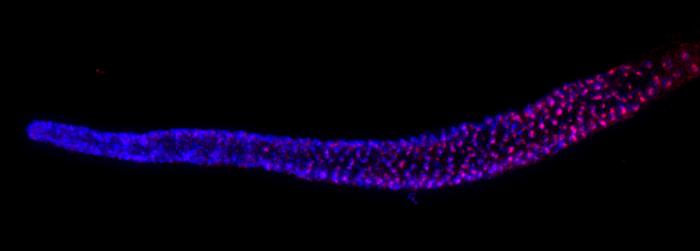An international research team led by researchers at RIKEN Center for Biosystems Dynamics Research (BDR) has solved a genetic mystery and revealed a previously unknown way that DNA can control what cells do. Headed by Hiroki Shibuya, PhD, the study reveals that in the roundworm C. elegans, vital RNA needed to keep the ends of chromosomes intact does not have its own gene. Instead, it hitchhikes inside another one. They suggest that DNA hitchhiking could be a common strategy in the animal kingdom, and has implications for anti-aging therapies and regenerative medicine in humans.
The team reported findings from the study in Science, in a paper titled “Nematode telomerase RNA hitchhikes on introns of germline-up-regulated genes,” in which they stated, “Our findings uncovered a species survival strategy in which telomerase RNA extends telomeres for the next generation by hitchhiking on introns of germline-expressed genes.”
Telomeres are DNA caps that protect the ends of chromosomes, much like the plastic tips of shoelaces. As we age, the cells of our bodies—called somatic cells—divide when we need new tissue, and every time that happens, the telomeres lose some of their DNA. “Telomeric DNA at chromosome ends shortens with each cell division, ultimately triggering cellular senescence,” the authors explained. Some signs of aging are related to this process. For example, skin cells with shorter telomeres make less collagen and the skin becomes wrinkled. When they are too short, cells self-destruct.
Sperm and egg precursor cells—collectively called germ cells—are an exception to this rule. When they divide, an enzyme called telomerase adds replacement DNA to the ends of shortened telomeres. Because of this, telomere length doesn’t get shorter with each generation, and species do not become extinct.
Telomerase contains an RNA template that is used to make the replacement DNA. “The core enzyme of telomerase consists of a catalytic reverse transcriptase and a template RNA,” the team continued. In humans and other mammals, this RNA comes from the TERC gene. C. elegans has working telomerase, but it doesn’t seem to have a TERC gene. This mystery has stumped scientists for more than 20 years, and some have assumed that the gene was lost during evolution. “Telomerase RNA remains unidentified in nematodes, including C. elegans, a classical model organism widely studied in various research fields, including telomere biology,” the team stated.
In their newly reported study, the team at RIKEN BDR discovered how C. elegans can exist without a standalone TERC gene. Because telomerase levels are normally very low, the researchers genetically engineered C. elegans to overproduce FLAG-TRT-1, the catalytic subunit of telomerase protein, which made it possible to collect large amounts of the whole telomerase complex, including the RNA template. “To search for the long-elusive nematode telomerase RNA, we generated a C. elegans strain overexpressing FLAG-TRT-1, the catalytic subunit of telomerase,” they stated. The scientists then used all the collected template RNA to search the genome for matching DNA.
Instead of being located in its own gene, which is the case in mammals, they found it inside another gene’s intron. Usually, the instructions in DNA within genes are used to build proteins. But some parts of genes, called introns, are not used to build proteins and are usually removed and discarded once the gene’s protein is made.
The authors explained further, “Biochemical purification of FLAG-TRT-1–associated RNAs using enhanced cross-linking and immunoprecipitation (eCLIP) identified an intronic long noncoding RNA (lncRNA), termed terc-1 (telomerase RNA component 1), within intron 2 of nmy-2, a germline−up-regulated gene encoding nonmuscle myosin II.” Shibuya continued, “It was surprising to find that the key RNA—which we have named terc-1—was hidden inside an intron of the gene called nmy-2, which is expressed only in germ cells. Indeed, the discovery that the essential telomerase RNA was hidden within an intron was completely unexpected.”
Experiments showed that in C. elegans lacking terc-1, telomeres became shorter each generation, and within 15 generations, the animals became extinct. “Mutations in terc-1 caused progressive telomere shortening and sterility over generations, establishing terc-1 as the first functional telomerase RNA expressed as an intronic lncRNA,” the investigators stated.
Inserting terc-1 inside the introns of other genes that are expressed in germ cells created roundworms that had normal telomeres and did not become extinct. In contrast, when terc-1 was inserted into introns of genes that only activate in somatic cells, the animals did become extinct. “Artificially transplanting the nmy-2 intron into the introns of germline-expressed genes but not non–germline-expressed genes restored germline immortality, highlighting the importance of genomic context,” the researchers further noted.
So, by hitching a ride inside genes activated in germ cells, terc-1 is produced where it is needed—the germ cells. There, it helps ensure that future generations do not receive shortened telomeres, thus supporting the survival of the species. “This unexpected regulatory mechanism, termed ‘intron hitchhiking,’ underscores the evolutionary adaptability of telomerase RNA and may reflect a broader strategy used by other noncoding RNAs involved in germline development and heritable trait transmission,” the investigators suggested.
Is this a unique instance of a functional RNA located in an intron and regulated by the host gene? The researchers do not think so. “Although we discovered this intron hitchhiking strategy in C. elegans, similar mechanisms are likely used by other noncoding RNAs or exist across different species,” said Shibuya. “This method of embedding RNAs so that the timing and location of their expression are automatically controlled by the host gene points to a broader principle in biology. Beyond its evolutionary significance, this discovery will help us better understand how telomerase is regulated in healthy cells and could transform approaches to aging, fertility, and regenerative medicine.”
In their paper, the team concluded, “The discovery of telomerase RNA expressed as an intronic lncRNA is unprecedented … Our discovery of the long-elusive terc-1 provides fundamental insights into mechanisms of germline immortality and species survival while also representing a distinct evolutionary offshoot of metazoan telomerase RNAs.”
